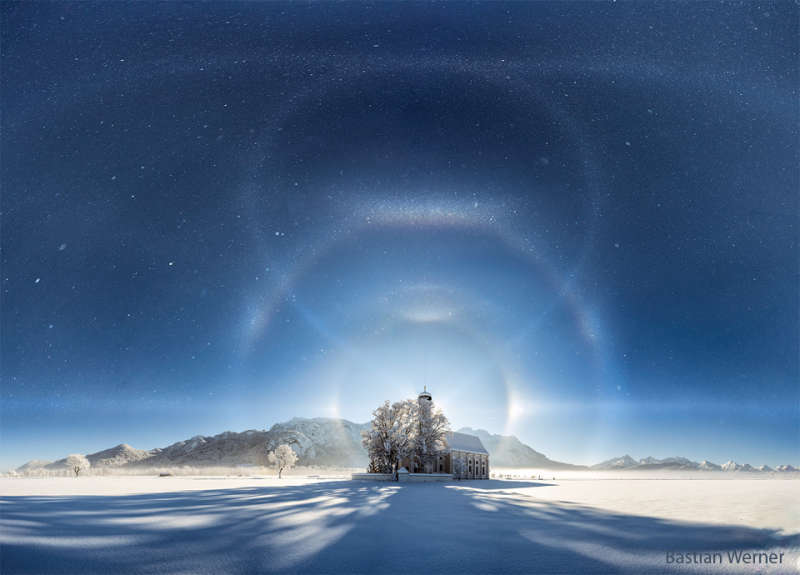Credit & Copyright: Bastian Werner
Explanation:
What's causing those unusual sky arcs?
Ice crystals.
While crossing a field of fresh snow near
Fcssen,
Bavaria,
Germany,
earlier this month, the photographer noticed that he had entered an ice fog.
For suspended water to freeze into an
ice fog
requires quite cold temperatures,
and indeed the air temperature on this day was measured at well below zero.
The ice fog
reflected light from the
Sun setting behind St.
Coleman Church.
The result was one of the
greatest
spectacles
the photographer has ever seen.
First, the spots in the
featured picture are not background stars but suspended ice and snow.
Next, two prominent
ice halos
are visible: the
22-degree halo and the
46-degree
halo.
Multiple arcs are also
visible,
including, from top to bottom,
antisolar (subsun),
circumzenithal,
Parry,
tangent, and
parhelic
(horizontal).
Finally, the
balloon shaped curve connecting
the top arc to the Sun is the
rarest of all: it is the
heliac arc, created by reflection from the sides of hexagonally shaped
ice crystals
suspended in a horizontal orientation.
1999 2000 2001 2002 2003 2004 2005 2006 2007 2008 2009 2010 2011 2012 2013 2014 2015 2016 2017 2018 2019 2020 2021 2022 2023 2024 2025 |
Yanvar' Fevral' Mart Aprel' Mai Iyun' Iyul' Avgust Sentyabr' Oktyabr' Noyabr' Dekabr' |
NASA Web Site Statements, Warnings, and Disclaimers
NASA Official: Jay Norris. Specific rights apply.
A service of: LHEA at NASA / GSFC
& Michigan Tech. U.
|
Publikacii s klyuchevymi slovami:
halo - galo
Publikacii so slovami: halo - galo | |
Sm. takzhe:
Vse publikacii na tu zhe temu >> | |
